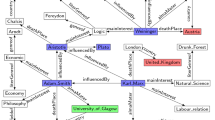Abstract
The ontology knowledge base can be divided into two parts: TBox and ABox, where the former models schema-level knowledge within the domain, and the latter is a statement of assertions or facts about a set of instances. ABox materialization is the process of discovering implicit assertions in ABox by reasoning based on existing knowledge, which is important in knowledge base applications. Ontology reasoning is a common method for ABox materialization. However, it is considered to be a computationally intensive operation and does not scale well for large-scale ABox. To solve this problem, this paper proposes an approximate reasoning hypothesis: materialization on the overall ABox is approximately equivalent to the collection of subgraph reasoning on ABox. Based on this hypothesis, a subgraph reasoning method for large-scale ABox materialization is proposed. Subgraph reasoning first divides ABox into instance-centered multi-hops subgraphs, then performs ontology reasoning on each subgraph, and finally takes the collection of all subgraph reasoning results as the result of ABox materialization. We conduct experiments on multiple open-source ontologies, and analyze the rationality of the approximate reasoning hypothesis. The experimental results show that subgraph reasoning can effectively improve the reasoning efficiency and achieve superior scalability for large-scale ABox materialization reasoning.
Access this chapter
Tax calculation will be finalised at checkout
Purchases are for personal use only
Similar content being viewed by others
References
Guarino, N., Oberle, D., Staab, S.: What is an ontology? In: Staab, S., Studer, R. (eds.) Handbook on Ontologies. IHIS, pp. 1–17. Springer, Heidelberg (2009). https://doi.org/10.1007/978-3-540-92673-3_0
Ian, H.: Historical ontology. In: In the Scope of Logic, Methodology, and Philosophy of Science, pp. 583–600. Springer, Dordrecht (2002). https://doi.org/10.1007/978-94-017-0475-5_13
Berners-Lee, T., Hendler, J., Lassila, O.: The semantic web. Sci. Am. 284(5), 34–43 (2001). https://doi.org/10.1038/35074206
Horrocks, I.: OWL: a description logic based ontology language. In: van Beek, P. (ed.) CP 2005. LNCS, vol. 3709, pp. 5–8. Springer, Heidelberg (2005). https://doi.org/10.1007/11564751_2
Glimm, B., Kazakov, Y., Liebig, T., Tran, T.-K., Vialard, V.: Abstraction refinement for ontology materialization. In: Mika, P., et al. (eds.) ISWC 2014. LNCS, vol. 8797, pp. 180–195. Springer, Cham (2014). https://doi.org/10.1007/978-3-319-11915-1_12
Gottschalk, S., Demidova, E.: EventKG: a multilingual event-centric temporal knowledge graph. In: Gangemi, A., et al. (eds.) ESWC 2018. LNCS, vol. 10843, pp. 272–287. Springer, Cham (2018). https://doi.org/10.1007/978-3-319-93417-4_18
Jia, Y., Qi, Y., Shang, H., Jiang, R., Li, A.: A practical approach to constructing a knowledge graph for cybersecurity. Engineering 4(01), 117–133 (2018). https://doi.org/10.1016/j.eng.2018.01.004
Alshahrani, M., Khan, M.A., Maddouri, O., et al.: Neuro-symbolic representation learning on biological knowledge graphs. Bioinformatics 33(17), 2723–2730 (2017). https://doi.org/10.1093/bioinformatics/btx275
Pan, J.Z., Ren, Y., Zhao, Y.: Tractable approximate deduction for OWL. Artif. Intell. 235, 95–155 (2016). https://doi.org/10.1016/j.artint.2015.10.004
Narayanan, S., Catalyurek, U., Kurc, T., et al.: Parallel materialization of large ABoxes. In: Proceedings of the 2009 ACM Symposium on Applied Computing, pp. 1257–1261 (2009). https://doi.org/10.1145/1529282.1529564
Rabbi, F., MacCaull, W., Faruqui, R.U.: A scalable ontology reasoner via incremental materialization. In: Proceedings of the 26th IEEE International Symposium on Computer-Based Medical Systems, pp. 221–226. IEEE (2013). https://doi.org/10.1109/CBMS.2013.6627792
Grau, B.C., Horrocks, I., Motik, B., et al.: OWL 2: the next step for OWL. J. Web Semant. 6(4), 309–322 (2008). https://doi.org/10.1016/j.websem.2008.05.001
Baader, F., Calvanese, D., McGuinness, D., Patel-Schneider, P., Nardi, D. (eds.): The Description Logic Handbook: Theory, Implementation and Applications. Cambridge University Press, Cambridge (2003)
Krötzsch, M.: OWL 2 profiles: an introduction to lightweight ontology languages. In: Eiter, T., Krennwallner, T. (eds.) Reasoning Web 2012. LNCS, vol. 7487, pp. 112–183. Springer, Heidelberg (2012). https://doi.org/10.1007/978-3-642-33158-9_4
Mehla, S., Jain, S.: Rule languages for the semantic web. In: Abraham, A., Dutta, P., Mandal, J.K., Bhattacharya, A., Dutta, S. (eds.) Emerging Technologies in Data Mining and Information Security. AISC, vol. 755, pp. 825–834. Springer, Singapore (2019). https://doi.org/10.1007/978-981-13-1951-8_73
Schmidt-Schauß, M., Smolka, G.: Attributive concept descriptions with complements. Artif. Intell. 48(1), 1–26 (1991). https://doi.org/10.1016/0004-3702(91)90078-X
Baumgartner, P.: Hyper tableau—the next generation. In: de Swart, H. (ed.) TABLEAUX 1998. LNCS (LNAI), vol. 1397, pp. 60–76. Springer, Heidelberg (1998). https://doi.org/10.1007/3-540-69778-0_14
Guo, Y., Pan, Z., Heflin, J.: LUBM: a benchmark for OWL knowledge base systems. J. Web Semant. 3(2–3), 158–182 (2005). https://doi.org/10.1016/j.websem.2005.06.005
Golbreich, C.: Combining rule and ontology reasoners for the semantic web. In: Antoniou, G., Boley, H. (eds.) RuleML 2004. LNCS, vol. 3323, pp. 6–22. Springer, Heidelberg (2004). https://doi.org/10.1007/978-3-540-30504-0_2
Katsumi, M., Grüninger, M.: Using PSL to extend and evaluate event ontologies. In: Bassiliades, N., Gottlob, G., Sadri, F., Paschke, A., Roman, D. (eds.) RuleML 2015. LNCS, vol. 9202, pp. 225–240. Springer, Cham (2015). https://doi.org/10.1007/978-3-319-21542-6_15
Batsakis, S., Tachmazidis, I., Antoniou, G.: Representing time and space for the semantic web. Int. J. Artif. Intell. Tools 26(03), 1750015.1-1750015.30 (2017). https://doi.org/10.1142/S0218213017600156
Sirin, E., Parsia, B., Grau, B.C., et al.: Pellet: a practical owl-dl reasoner. J. Web Semant. 5(2), 51–53 (2007). https://doi.org/10.1016/j.websem.2007.03.004
Bin, L., Hang, C., Min, L., et al.: A graph data synthesis method, device, computer device and storage medium. Patent for Invention (2021)
Lassila, O., Swick, R.R.: Resource description framework (RDF) model and syntax specification (1998)
Author information
Authors and Affiliations
Corresponding author
Editor information
Editors and Affiliations
Rights and permissions
Copyright information
© 2022 The Author(s), under exclusive license to Springer Nature Switzerland AG
About this paper
Cite this paper
Zhu, X., Lin, B., Ding, Z., Yao, L., Zhu, C. (2022). Implementing Large-Scale ABox Materialization Using Subgraph Reasoning. In: Memmi, G., Yang, B., Kong, L., Zhang, T., Qiu, M. (eds) Knowledge Science, Engineering and Management. KSEM 2022. Lecture Notes in Computer Science(), vol 13368. Springer, Cham. https://doi.org/10.1007/978-3-031-10983-6_48
Download citation
DOI: https://doi.org/10.1007/978-3-031-10983-6_48
Published:
Publisher Name: Springer, Cham
Print ISBN: 978-3-031-10982-9
Online ISBN: 978-3-031-10983-6
eBook Packages: Computer ScienceComputer Science (R0)




